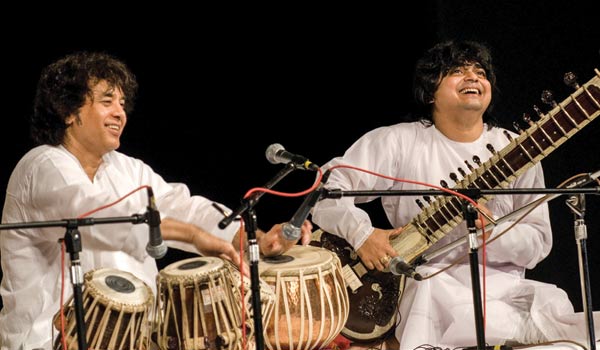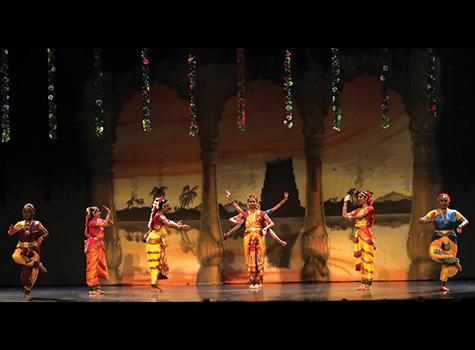
This is the second time I have interviewed the master of the tabla, Ustad Zakir Hussain. It’s always a quandary to interview someone who has such a vast history in music. You want to ask him questions that he has likely answered a thousand times. But Zakir Hussain is a down-to-earth musician. I posed questions that I wanted to ask and he answered them in detail, just like the first time I interviewed him a few years ago when he was touring with his Masters of Percussion.
His musical history is legendary. He has connected with musical traditions around the globe and performed with musicians as diverse as Herbie Hancock, Bela Fleck, Mickey Hart, John McLaughlin, Ravi Shankar, Bill Laswell and Charles Lloyd. It is an exhausting list of musical masters who have also benefited from performing with Ustad Hussain.
Hussain is slated to perform in the Carolinas in early October with Niladri Kumar, a brilliant and accomplished sitar master. This pairing is a gift to lovers of Hindustani music. It will be a top-notch performance exploring India’s North Indian classical music that harks back centuries.
According to the program notes I received, “This concert will present an exploration of Indian music, both ancient and cutting-edge, combining a traditional classical offering with a collaborative exploration of the raga and tala systems. The concert will begin with a rendition of a classical raga performed on sitar by Niladri Kumar and accompanied on tabla by Zakir Hussain. This piece will commence with a full alaap by Niladri Kumar in the Hindustani classical tradition, presenting and expounding on the raga. The concert will also include a tabla solo piece by Hussain, and will conclude with a contemporary performance based on the folk melodies of India.”
These performances are the classic duet interactions where the musicians are so in tune with each other that they practically read each other’s minds. Hussain’s tabla will open a world of sound while Kumar’s sinewy sitar resonates sounds both meditative and jubilant, depending on the moment.
Here’s a portion of my recent chat with Zakir Hussain.
I asked him to talk a bit about this performance. He said “this will not be a Masters of Percussion or anything like a fusion performance. This will be a detailed classical performance. I don’t get to do many performances like this so it’s nice to be able to have this opportunity. Let’s see if I can still keep up with these young punks (laughs while referring to Niladri Kumar).”
Kumar is lightning fast on the sitar. “Yeah, to put it mildly, he is 2 point something gigawatts of power. There’s power there but also great attention to the traditional requirements. He’s a very special combination of traditional values and their validity in the modern world of music. He can play in both worlds comfortably and with the same amount of confidence.”
When I asked him if his and Kumar’s work with fusion as well as varied musicians and genres brings more fans into the traditional Indian music fold, Hussain explained, “You know music must move forward. If it doesn’t it’ll stagnate. Therefore, you must found new avenues and language to express this traditional form. You have to speak in various tongues to be able to get the music’s point across. You must deal with what’s out there. And whether that helps you, I would say yes because for myself I would have to say my association with a lot of Western musicians and like jazz musicians or percussionists or drummers has really enhanced my ability to be able to play my tabla in a more I would say global manner. And so I’m able to take compositions and interpret them in a way where a drummer could understand it and easily document it to be able to execute the same information on his drum or a conga drummer could do it…and adapt those compositions to be able to work in the world of jazz, rock, pop or hip hop or whatever. All these interactions have allowed me to understand languages of expressions and that allows me to expand my traditional expression into those forms. I’m sure Niladri is having similar experiences, having invented a new instrument (zitar), playing funk music or playing in films and Bollywood, doing all that stuff. It develops you as a more complete performer and representative of the art form to be able to discover ways in which the sitar (or tabla) has never been played. And therefore discover what your instrument is really fully capable of.”
Of all the genres of music you have played with, which one has personally challenged you most, I asked.
“Strangely enough, Western classical music. The reason why I say that because jazz and Indian music are somewhat distant cousins and also Celtic music. They all have elements of improvisation and therefore spontaneity plays an important role in the musical expression. In that way you are somewhat on familiar ground. If you understand the language of the music you are interacting with then you can speak the language and are able to fit in more easily than you would with music that is totally opposite. So when you think about Indian classical music as an improv form of music and western classical music which is a fixed form of music and has an element that Indian music does not have which is harmony and counter point where four notes are played at the same time, and then you suddenly end up with a 95-piece orchestra and you have to figure out that you are not just interacting with one or two musicians who are just as ready to be spontaneous and improvise in the musical form you are connecting with. But more like this (an orchestra) has to be fixed. It has to be written and different parts have to be handed out to all these many musicians and now you are thinking of all these things and in that sense it’s much more challenging. I used to think it was easy but recently I had to write a tabla concerto in a full orchestra and it was a big challenge to make that happen.”
When asked what he thought his legacy will be or what he wants to leave behind, he talked about his ongoing work of standardizing the “gharanas” (the regional schools) of Hindustani music. He said he wants to “Gather all the elements of all the gharanas and combine them into one system of study.” The gurus of different gharanas have different styles and modes of teaching, and Hussain wants to simplify that. He is working with other musicians and gurus to create a codified manner of studying classical music much in the manner that Indian classical dance was codified in “Natya Shastra” or loosely interpreted as Study of Dance.
When I spoke with him, Hussain had just returned from Japan. They both performed in Kyoto, Japan in early September in front of Indian religious leader Morari Bapu. “It was a gathering of Buddhist and katha oriented priests of India, and what I was supposed to do was go there and say a few words about music and its association with spirituality and then a performance. I asked Niladriji (to join me) and he said yes and so we went there and did that. And now I go back to Japan to Tokyo next week (mid-Sept). I have a concert. I’m opening a new concert hall that they have built and they wanted to start it with my tabla solo. It will be a traditional solo recital.
This fall he is touring with Niladri Kumar. He returns to India in January and will perform in Rajkot and then in Amdavad at the famous Saptak Music Festival, where he has performed numerous times in the past.
This is the running legacy of Ustad Zakir Hussain, a troubadour of Indian music, an all-around performer.
Zakir Hussain and Niladri Kumar Concerts:
**Sat, October 8 (8pm) at Page Auditorium – Durham, NC
dukeperformances.duke.edu
**Sun, October 9 (4pm) at Halton Theater – Charlotte, NC
www.ipaac.org/Zakir.htm
**Mon, October 10 (7:30pm) Peace Center for Performing Arts Gunter Theatre – Greenville, SC
peacecenter.org/events/detail/zakir-hussain-and-niladri-kumar



